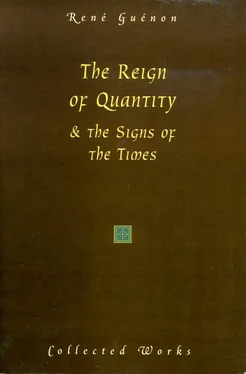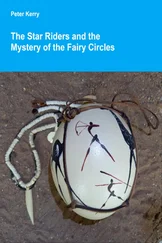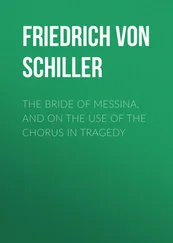The cube also represents the earth in all the traditional meanings of that word, that is, not only the earth as a corporeal element in the sense in which it was mentioned above, but also as a principle of a much more universal order, the principle designated in the Far-Eastern tradition as Earth ( Ti ) in correlation with Heaven ( Tien ). Spherical or circular forms are related to Heaven, cubic or square forms to Earth; since these two complementary terms are the equivalents of Purusha and Prakriti in the Hindu doctrine, which means that they are simply another expression for essence and substance taken in their universal meaning, exactly the same conclusion as before is arrived at in this instance. It is also evident that, like the conceptions of essence and substance, the same symbolism is always susceptible of application at different levels, that is to say either to the principles of a particular state of existence, or to the integrality of universal manifestation. Not only are these two geometrical forms related to Heaven and to Earth, but so also are the instruments used to draw them, namely, the compass and the square, and this is so in the symbolism of the Far-Eastern tradition as well as in that of Western initiatic traditions; [62] In certain symbolical representations the compass and the square respectively are placed in the hands of Fu Hsi and his sister Niu-koua, just as, in the alchemical figures of Basil Valentine, they are placed in the hands of the two halves, masculine and feminine, of the Rebis or Hermetic Androgyne; this shows that Fu Hsi and Niu-koua are in a sense analogically assimilated, as regards their respective functions, to the essential or masculine principle and to the substantial or feminine principle of manifestation.
and the different correspondences of these two forms give rise in different circumstances to multiple symbolical and ritual applications. [63] Thus, for example, the ritual garments of the ancient sovereigns in China had to be round in shape at the top and square at the bottom; the sovereign then represented the type of man himself ( Jen ) in his cosmic function, as the third term of the ‘Great Triad’, exercising that function as intermediary between Heaven and Earth, and uniting in himself the powers of both.
Another case in which the relation of these same geometrical forms is in evidence is that of the symbolism of the ‘Terrestrial Paradise’ and of the ‘Heavenly Jerusalem’, to which reference has already been made elsewhere; [64] See The King of the World , also The Symbolism of the Cross , chap. 9.
and this case is specially important from the point of view adopted in this book, since the symbolism in question is in fact concerned with the two extremities of the present cycle. Now the form of the ‘Terrestrial Paradise’, corresponding to the beginning of the cycle, is circular, whereas that of the ‘Heavenly Jerusalem’, corresponding to its end, is square; [65] If this is compared with the correspondences previously pointed out, it might appear that there had been an inversion in the use of the two words ‘Heavenly’ and ‘Terrestrial’ and there is in fact a discrepancy, except in the following particular connection: at the beginning of the cycle, this world was not such as it is now, and the ‘Terrestrial Paradise’ constituted the direct projection, at that time visibly manifested, of the specifically celestial and principial form (it was besides situated in a sense at the confines of heaven and earth, since it is said that it touched the ‘sphere of the Moon’, that is, the ‘first heaven’); at the end of the cycle, the ‘Heavenly Jerusalem’ descends from heaven to earth, and it is only at the end of that descent that it appears in the form of a square, because then the cyclic movement has come to a stop.
and the circular boundary of the ‘Terrestrial Paradise’ is none other than the horizontal section of the ‘Egg of the World’, that is of the universal and primordial spherical form. [66] It is worth noting that this circle is divided up by the cross formed by the four rivers which rise at its center, thus giving exactly the figure alluded to when the relation of the circle and the square was being dealt with.
It could be said that this circle itself is finally changed into a square, since the two extremities must join, or rather (the cycle never being really closed, for that would imply an impossible repetition) they must correspond exactly; the presence of the same ‘Tree of Life’ in the center in each case shows clearly that it is only actually a question of two states of one and the same thing, the square here representing the accomplishment of the possibilities of the cycle, which were in a germinal condition in the circular ‘organic girdle’ of the beginning, and are subsequently fixed and stabilized in a state of definition so to speak, at least in relation to the particular cycle concerned. This final result can also be represented as a ‘crystallization’, again showing affinity with the cubic form (or the square in the plane section): it becomes a ‘city’ with a mineral symbolism, whereas at the beginning there was a ‘garden’ with a vegetable symbolism, vegetation representing the elaboration of the germs in the sphere of vital assimilation. [67] See The Esoterism of Dante .
Reference was made above to the immobility of minerals as being an image of the final state toward which the ‘solidification’ of the world is tending: but it is as well to add that in considering the ‘Heavenly Jerusalem’ the mineral has been regarded as already being in a ‘transformed’ or ‘sublimated’ state, for it figures as precious stones in the description of that City; that is why the fixation is only final with respect to the present cycle, and beyond the ‘stopping-point’ the same ‘Heavenly Jerusalem’ must, by virtue of the causal linkage that admits of no actual discontinuity, become the ‘Terrestrial Paradise’ of the future cycle, the end of the one and the beginning of the other being actually one and the same moment viewed from two opposite sides. [68] This moment is also represented as that of the ‘reversal of the poles’ or as the day when ‘the stars will rise in the West and set in the East’, for a rotational movement appears to take place in two opposite directions according as it is looked at from one side or the other, though it is really always the same continuous movement, but seen from another point of view, corresponding to the course of a new cycle.
It is nonetheless true that, if consideration is confined to the present cycle, a moment finally arrives at which ‘the wheel stops turning’, and here, as always, the symbolism is perfectly coherent: for a wheel is circular in shape, and if it were to get out of shape in such a way as to end by being square, it is obvious that it could not do otherwise than stop. This is why the moment in question appears as an ‘end of time’; it is then, according to the Hindu tradition, that the ‘twelve suns’ will shine simultaneously, for time is in fact measured by the passage of the sun through the twelve signs of the zodiac, making the annual cycle, and when the rotation is stopped, the twelve corresponding aspects will so to speak be merged into one, thus returning into the essential and primordial unity of their common nature, since they do not differ except in their relation to universal manifestation, which will then be at an end. [69] See The King of the World . The twelve signs of the zodiac, instead of being arranged in a circle, become the twelve gates of the ‘Heavenly Jerusalem’, three being placed on each side of the square, and the ‘twelve suns’ appear in the center of the ‘city’ as the twelve fruits of the ‘Tree of Life’.
Moreover, the changing of the circle into an equivalent square [70] That is, a square of the same surface area, if a quantitative point of view is adopted; but this is merely a wholly exteriorized expression of what is really in question.
is also what is known as the ‘squaring of the circle’; those who declare that this is an insoluble problem, though they be wholly unaware of its symbolical significance, are thus right in fact, since the ‘squaring’ understood in its true sense cannot be realized until the end of the cycle. [71] The corresponding numerical formula is that of the Pythagorean Tetraktys : 1 + 2 + 3 + 4 = 10; if the numbers are taken in the reverse order: 4 + 3 + 2 + 1, this gives the proportions of the four Yugas , the sum of which is the denary, that is to say the complete and finished cycle.
Читать дальше











